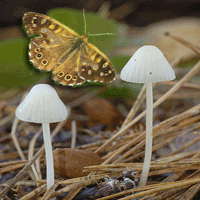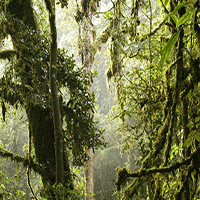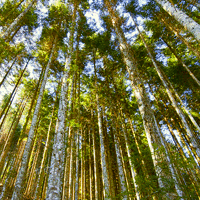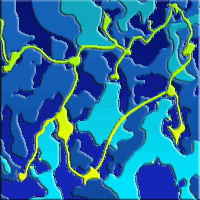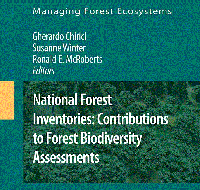Forest structural complexity arises from several attributes whose combined effects make it difficult to disentangle their single contributions. Such contributions may vary substantially across different ecosystems and management types, requiring the development of fast and effective forest structural evaluation indices for simplified, highly managed systems, such as poplar plantations in riparian areas. With this aim, the suitability of the Index of Biodiversity Potential (IBP) to catch the stand structural variations was tested in three different types of poplar forests (cultivated, semi-natural and natural) along the Po river (Northen Italy) in contrast with quantitative structural parameters (e.g., deadwood biomass, diameter diversity) and synthetic structural complexity indices (Index of Structural Heterogeneity - SHI, Forest Structure Index - FSI). The IBP consistently assessed stand structure complexity using structural parameters and synthetic indices. The Gini coefficient for diameter was generally low among sites, but the IBP identified slight variations in vertical structure enabling differentiation between cultivated and non-cultivated stands. The SHI showed the strongest correlation with IBP, likely due to its context-related features and its ability to describe structural differences within a relatively homogeneous forest stand. Although data on the presence of large woody elements in IBP allow distinctions among stand types, the lack of their quantification may lead to an overestimation of their actual role in forest biogeochemical cycles. In conclusion, the IBP, with some site-specific refinements, could represent a suitable and rapid method for implementing management plans to enhance woodland stand complexity in riparian areas.
Keywords
, , , , , ,
Citation
Trentanovi G, Corli A, Orsenigo S, Ghirelli P, Chiarabaglio PM, Traversi ML, Traversari S, Vannucchi F, Giovannelli A (2025). Consistency among forest structure and biodiversity potential index (IBP): an assessment of stand structural complexity for floodplain poplar woodlands. iForest 18: 335-343. - doi: 10.3832/ifor4945-018
Academic Editor
Marco Borghetti
Paper history
Received: Jul 21, 2025
Accepted: Oct 27, 2025
First online: Nov 04, 2025
Publication Date: Dec 31, 2025
Publication Time: 0.27 months
© SISEF - The Italian Society of Silviculture and Forest Ecology 2025
Open Access
This article is distributed under the terms of the Creative Commons Attribution-Non Commercial 4.0 International (https://creativecommons.org/licenses/by-nc/4.0/), which permits unrestricted use, distribution, and reproduction in any medium, provided you give appropriate credit to the original author(s) and the source, provide a link to the Creative Commons license, and indicate if changes were made.

Breakdown by View Type
(Waiting for server response...)
Article Usage
Total Article Views: 296
(from publication date up to now)
Breakdown by View Type
HTML Page Views: 67
Abstract Page Views: 160
PDF Downloads: 65
Citation/Reference Downloads: 0
XML Downloads: 4
Web Metrics
Days since publication: 4
Overall contacts: 296
Avg. contacts per week: 518.00
Article Citations
Article citations are based on data periodically collected from the Clarivate Web of Science web site
(last update: Mar 2025)
(No citations were found up to date. Please come back later)
Publication Metrics
by Dimensions ©
Articles citing this article
List of the papers citing this article based on CrossRef Cited-by.
(1)
Aakala T, Kuuluvainen T, Gauthier S, De Grandpré L (2008)Standing dead trees and their decay-class dynamics in the northeastern boreal old-growth forests of Quebec. Forest Ecology and Management 255 (3-4): 410-420.
CrossRef |
Gscholar
(2)
Aguirre O, Hui G, Von Gadow K, Jiménez J (2003)An analysis of spatial forest structure using neighbourhood-based variables. Forest Ecology and Management 183 (1-3): 137-145.
CrossRef |
Gscholar
(3)
Barnett JL, How RA, Humphreys WF (1978)The use of habitat components by small mammals in eastern Australia. Australian Journal of Ecology 3: 277-285.
CrossRef |
Gscholar
(4)
Bouget C, Larrieu L, Brin A (2014)Key features for saproxylic beetle diversity derived from rapid habitat assessment in temperate forests. Ecological Indicators 36: 656-664.
CrossRef |
Gscholar
(5)
Braga SR, Oliveira MLR, Gorgens EB (2020)Forestmangr: forest mensuration and management. R Package version 0.9, CRAN R-Project, pp. 82.
Online |
Gscholar
(6)
Brunet J, Isacsson G (2009)Influence of snag characteristics on saproxylic beetle assemblages in a south Swedish beech forest. Journal of Insect Conservation 13: 515-528.
CrossRef |
Gscholar
(7)
Burrascano S, Keeton WS, Sabatini FM, Blasi C (2013)Commonality and variability in the structural attributes of moist temperate old-growth forests: a global review. Forest Ecology and Management 291: 458-479.
CrossRef |
Gscholar
(8)
Burrascano S, Trentanovi G, Paillet Y, Heilmann-Clausen J, Giordani P, Bagella S, Bravo-Oviedo A, Campagnaro T, Campanaro A, Chianucci F, De Smedt P, García-Mijangos I, Matošević D, Sitzia T, Aszalós R, Brazaitis G, Cutini A, Andrea E, Doerfler I, Hofmeister J, Hošek J, Jannsen P, Kepfer Rojas S, Korboulewsky N, Kozák D, Lachat T, Lõhmus A, Lopez R, Mårell A, Matula R, Mikoláš M, Munzi S, Nordén B, Pärtel M, Penner J, Runnel K, Schall P, Svoboda M, Tinya F, Ujházyová M, Vandekerkhove K, Verheyen K, Xystrakis F, Odor P (2021)Handbook of field sampling for multi-taxon biodiversity studies in European forests. Ecological Indicators 132: 108266.
CrossRef |
Gscholar
(9)
Burrascano S, Chianucci F, Trentanovi G, Kepfer-Rojas S, Sitzia T, Tinya F, Doerfler I, Paillet Y, Nagel TA, Mitic B, Morillas L, Munzi S, Van Der Sluis T, Alterio E, Balducci L, Barreto De Andrade R, Bouget C, Giordani P, Lachat T, Matosevic D, Napoleone F, Nascimbene J, Paniccia C, Roth N, Aszalós R, Brazaitis G, Cutini A, Andrea E, De Smedt P, Heilmann-Clausen J, Jannsen P, Kozák D, Mårell A, Mikoláš M, Nordén B, Matula R, Schall P, Svoboda M, Ujhazyova M, Vandekerkhove K, Wohlwend M, Xystrakis F, Aleffi M, Ammer C, Archaux F, Asbeck T, Avtzis D, Ayasse M, Bagella S, Balestrieri R, Barbati A, Basile M, Bergamini A, Bertini G, Biscaccianti AB, Boch S, Bölöni J, Bombi P, Boscardin Y, Brunialti G, Henrik Bruun H, Buscot F, Bille Byriel D, Campagnaro T, Campanaro A, Chauvat M, Ciach M, Cistrone L, Cordeiro Pereira JM, Daniel R, De Cinti B, De Filippo G, Dekoninck W, Di Salvatore U, Dumas Y, Elek Z, Ferretti F, Fotakis D, Frank T, Frey J, Giancola C, Gomoryová E, Gosselin M, Gosselin F, Gossner MM, Götmark F, Haeler E, Kappel Hansen A, Hertzog L, Hofmeister J, Hošek J, Kvist Johannsen V, Just Justensen M, Korboulewsky N, Kovács B, Lakatos F, Landivar CM, Lens L, Lingua E, Lombardi F, Máliš F, Marchino L, Marozas V, Matteucci G, Mattioli W, Friis Mller P, Müller J, Németh C, Onodi G, Parisi F, Perot T, Perret S, Persiani AM, Portaccio A, Posillico M, Preikša Z, Rahbek C, Rappa NJ, Ravera S, Romano A, Samu F, Scheidegger C, Kappel Schmidt I, Schwegmann S, Sicuriello F, Petronela Spinu A, Spyroglou G, Stillhard J, Topalidou E, Tttrup AP, Ujházy K, Veres K, Verheyen K, Weisser WW, Zapponi L, Odor P (2023)Where are we now with European forest multi-taxon biodiversity and where can we head to? Biological Conservation 284: 110176.
CrossRef |
Gscholar
(10)
Cantamessa S, Chiarabaglio PM, Rizza D, Debernardi G, Bergante S (2024)Improving carbon sequestration in wetlands using native poplar genotypes for reforestation purposes. Forests 15(9), 1641.
CrossRef |
Gscholar
(11)
Corona P, Bergante S, Castro G, Chiarabaglio PM, Coaloa D, Facciotto G, Gennaro M, Giorcelli A, Rosso L, Vietto L, Nervo G (2023)Italian hybrid poplar clones with greater environmental sustainability. Rete Rurale Nazionale, Consiglio per la ricerca in agricoltura e l’analisi dell’economia agraria, Rome, Italy, pp. 40.
Gscholar
(12)
Cosović M, Bugalho MN, Thom D, Borges JG (2020)Stand structural characteristics are the most practical biodiversity indicators for forest management planning in Europe. Forests 11 (3): 343.
CrossRef |
Gscholar
(13)
Courbaud B, Larrieu L, Kozak D, Kraus D, Lachat T, Ladet S, Müller J, Paillet Y, Sagheb-Talebi K, Schuck A, Stillhard J, Svoboda M, Zudin S (2022)Factors influencing the rate of formation of tree-related microhabitats and implications for biodiversity conservation and forest management. Journal of Applied Ecology 59 (2): 492-503.
CrossRef |
Gscholar
(14)
Corenblit D, Steiger J, González E, Gurnell AM, Charrier G, Darrozes J, Dousseau J, Julien F, Lambs L, Larrue S, Roussel E, Vautier F, Voldoire O (2014)The bio geomorphological life cycle of poplars during the fluvial geomorphological succession: a special focus on
Populus nigra L. Earth Surface Processes and Landforms 39: 546-563.
CrossRef |
Gscholar
(15)
Corli A, Vannucchi V, Traversari S, Orsenigo S, Giovannelli A, Chiarabaglio PM, Chianucci F, Calfapietra C, Scartazza A, Mascherpa MC, Traversi ML, Cristaldi L, Trentanovi G (2025)Drivers of vascular species diversity on floodplain poplar (
Populus spp.) stands: an integrated approach for ecological and functional assessment. Forest Ecology and Management 595: 123000.
CrossRef |
Gscholar
(16)
European Commission (2021)Communication from the Commission to the European Parliament, the Council, the European Economic and Social Committee and the Committee of the Regions - New EU Forest Strategy for 2030. COM (2021) 572 Final Communication, EUR-lex, website.
Online |
Gscholar
(17)
Friendly M (2002)Corrgrams: exploratory displays for correlation matrices. The American Statistician 56: 316-324.
CrossRef |
Gscholar
(18)
Gadow K, Zhang C, Wehenkel C, Pommerening A, Corral-Rivas J, Korol M, Myklush S, Hui G, Kiviste A, Zhao X (2012)Forest structure and diversity. In: “Continuous Cover Forestry” (Pukkala T, Kv G eds), 2nd edn. Springer, Dordrecht, Netherlands, pp. 29-84.
CrossRef |
Gscholar
(19)
Gonin P, Larrieu L, Miozzo M, Corezzola S (2022)Definizione dell’indice di Biodiversità Potenziale per le foreste italiane [Definition of the Index of Biodiversity Potential for Italian forests] (IBP It v3. 0). CNPF, INRAE Dynafor, D.R.E.Am Italia, pp. 5. [in Italian]
Gscholar
(21)
Hämäläinen A, Runnel K, Ranius T, Strengbom J (2024)Diversity of forest structures important for biodiversity is determined by the combined effects of productivity, stand age, and management. Ambio 53: 718-729.
CrossRef |
Gscholar
(22)
Heidrich L, Bae S, Levick S, Seibold S, Weisser W, Krzystek P, Magdon P, Nauss T, Schall P, Serebryanyk A, Wöllauer S, Ammer C, Bässler C, Doerfler I, Fischer M, Gossner MM, Heurich M, Hothorn T, Jung K, Kreft H, Schulze ED, Simons N, Thorn S, Müller J (2020)Heterogeneity-diversity relationships differ between and within trophic levels in temperate forests. Nature Ecology and Evolution 4 (9): 1204-1212.
CrossRef |
Gscholar
(23)
Keren S, Svoboda M, Janda P, Nagel TA (2020)Relationships between structural indices and conventional stand attributes in an old-growth forest in Southeast Europe. Forests 11 (1): 4.
CrossRef |
Gscholar
(24)
Larrieu L, Gonin P (2008)L’indice de biodiversité potentielle (IBP): une méthode simple et rapide pour évaluer la biodiversité potentielle des peuplements forestiers [The Index of Biodiversity Potential (IBP): a simple and rapid method for assessing the potential biodiversity of forest stands]. Revue Forestière Française 60 (6): 727-748. [in French]
CrossRef |
Gscholar
(25)
Larrieu L, Cabanettes A, Sarthou JP (2015)Hoverfly (Diptera: Syrphidae) richness and abundance vary with forest stand heterogeneity: preliminary evidence from a montane beech fir forest. European Journal of Entomology 112 (4): 755-769.
CrossRef |
Gscholar
(26)
Lexerød NL, Eid T (2006)An evaluation of different diameter diversity indices based on criteria related to forest management planning. Forest Ecology and Management 222 (1-3): 17-28.
CrossRef |
Gscholar
(27)
Magurran AE (2004)Measuring biological diversity. Blackwell Science, Oxford, UK, pp. 106-108.
Gscholar
(28)
Marshall PL, Davis G, LeMay WM (2000)Using line intersect sampling for coarse woody debris. Technical Report TR-003, Research Section, Vancouver Forest Region, Vancouver, Canada, pp. 10.
Gscholar
(29)
Martín-García J, Jactel H, Oria-De-Rueda JA, Diez JJ (2016)The effects of poplar plantations on vascular plant diversity in riparian landscapes. Forests 7 (3): 50.
CrossRef |
Gscholar
(30)
McElhinny C, Gibbons P, Brack C (2006)An objective and quantitative methodology for constructing an index of stand structural complexity. Forest Ecology and Management 235 (1-3): 54-71.
CrossRef |
Gscholar
(31)
McElhinny C, Gibbons P, Brack C, Bauhus J (2005)Forest and woodland stand structural complexity: its definition and measurement. Forest Ecology and Management 218 (1-3): 1-24.
CrossRef |
Gscholar
(32)
Knuff AK, Staab M, Frey J, Dormann CF, Asbeck T, Klein AM (2020)Insect abundance in managed forests benefits from multi-layered vegetation. Basic and Applied Ecology 48: 124-135.
CrossRef |
Gscholar
(33)
Kassambara A, Kassambara MA (2020)Package “ggpubr”. CRAN R-Project, Web site.
Online |
Gscholar
(34)
Kremer K, Promis A, Bauhus J (2022)Natural advance regeneration of native tree species in
Pinus radiata plantations of South-Central Chile suggests potential for a passive restoration approach. Ecosystems 25 (5): 1096-1116.
CrossRef |
Gscholar
(35)
Kruskal WH, Wallis WA (1952)Use of ranks in one-criterion variance analysis. Journal of the American Statistical Association 47: 583-621.
CrossRef |
Gscholar
(36)
Müller J, Boch S, Blaser S, Fischer M, Prati D (2015)Effects of forest management on bryophyte communities on deadwood. Nova Hedwigia 100 (3-4): 423-438.
CrossRef |
Gscholar
(37)
Ostellino I (2011)Rarità naturali: Il ruolo della biodiversità nel paesaggio dei fiumi e della collina torinese [Natural rarities: the role of biodiversity in the landscape of the rivers and the Turin hills]. In: Atti del seminario del 18 marzo 2010, Moncalieri (Torino), e delle attività nell’ambito di Rarità Naturali - Paesaggio Zero, Seconda Biennale dell’Osservatorio del Paesaggio dei Parchi del Po e della Collina Torinese. Politecnico di Torino, Torino, Italy, pp. 122. [in Italian]
Gscholar
(38)
Patil I (2021)Visualizations with statistical details: the “ggstatsplot” approach. Journal of Open Source Software 6: 3167.
CrossRef |
Gscholar
(39)
Porro Z, Odicino M, Bogliani G, Chiatante G (2021)Intensive forestry and biodiversity: use of poplar plantations by woodpeckers in a lowland area of Northern Italy. Forest Ecology and Management 497: 119490.
CrossRef |
Gscholar
(40)
Puletti N, Castaldi C, Marchi M, Scotti R (2017)ForIT: functions from the 2nd Italian forest inventory (INFC). CRAN R-Project, web site.
CrossRef |
Gscholar
(41)
R Core Team (2021)R: a language and environment for statistical computing. R Foundation for Statistical Computing: Vienna, Austria,
Online |
Gscholar
(42)
Schall P, Schulze ED, Fischer M, Ayasse M, Ammer C (2018)Relations between forest management, stand structure and productivity across different types of Central European forests. Basic and Applied Ecology 32: 39-52.
CrossRef |
Gscholar
(43)
Sabatini FM, Burrascano S, Lombardi F, Chirici G, Blasi C (2015)An index of structural complexity for Apennine beech forests. iForest 8: 314-323.
CrossRef |
Gscholar
(44)
Sanaei A, Ali A, Yuan Z, Liu S, Lin F, Fang S, Ye J, Hao Z, Loreau M, Bai E, Wang X (2021)Context-dependency of tree species diversity, trait composition and stand structural attributes regulate temperate forest multifunctionality. Science of The Total Environment 757: 143724.
CrossRef |
Gscholar
(45)
Smulders MJM, Cottrell JE, Lefèvre F, Van Schoot J, Arens P, Vosman B, Tabbner HE, Grassi F, Fossati T, Castiglione S, Krystufek V, Fluch S, Burg K, Vornam B, Pohl A, Gebhardt K, Alba N, Agúndez D, Maestro C, Notivol E, Volosyanchuk R, Pospíšková M, Bordács S, Bovenschen J, Van Dam BC, Koelewiin HP, Halfmaerten D, Ivens B, Van Slycken Vanden Broeck BC, Storme V, Boerjan W (2008)Structure of the genetic diversity in black poplar (
Populus nigra L.) populations across European river systems: consequences for conservation and restoration. Forest Ecology and Management 255 (5-6): 1388-1399.
CrossRef |
Gscholar
(46)
Storch F, Dormann CF, Bauhus J (2018)Quantifying forest structural diversity based on large-scale inventory data: a new approach to support biodiversity monitoring. Forest Ecosystem 5 (1): 34.
CrossRef |
Gscholar
(47)
Storch F, Boch S, Gossner MM, Feldhaar H, Ammer C, Schall P, Kroiher F, Müller J, Bauhus J (2023)Linking structure and species richness to support forest biodiversity monitoring at large scales. Annals of Forest Science 80: 3.
CrossRef |
Gscholar
(48)
Tabacchi G, Di Cosmo L, Gasparini P, Morelli S (2011)Stima del volume e della fitomassa delle principali specie forestali italiane. Equazioni di previsione, tavole del volume e tavole della fitomassa arborea epigea [Estimation of volume and phytomass of the main Italian forest species. Prediction equations, volume tables and aboveground tree phytomass tables]. Consiglio per la Ricerca e la sperimentazione in Agricoltura, Unità di Ricerca per il Monitoraggio e la Pianificazione Forestale, Trento, Italy, pp. 412. [in Italian]
Gscholar
(49)
Tinschert E, Egger G, Wendelga J, Heinze B, Rood SB (2020)Alternate reproductive strategies of
Populus nigra influence diversity, structure and successional processes within riparian woodlands along the Allier River, France. Journal of Hydro-Environment Research 30: 100-108.
CrossRef |
Gscholar
(50)
Van Wagner CE (1968)The line intersect method in forest fuel sampling. Forest Science 14 (1): 20-26.
CrossRef |
Gscholar
(51)
Veerkamp C, Ramieri E, Romanovska L, Zandersen Förster J, Rogger M, Martinsen L (2021)Assessment frameworks of nature-based solutions for climate change adaptation and disaster risk reduction. Technical Paper 2021/3, European Topic Centre on Climate Change impacts, Vulnerability and Adaptation (ETC/CCA), Bologna, Italy, pp. 103.
Online |
Gscholar
(52)
Waddell KL (2002)Sampling coarse woody debris for multiple attributes in extensive resource inventories. Ecological indicators 1 (3): 139-153.
CrossRef |
Gscholar
(53)
Wei T, Simko V (2024)R package “corrplot”: visualization of a correlation matrix (version 0.95). GitHub, Web site.
Online |
Gscholar
(54)
Whitman AA, Hagan JM (2007)An index to identify late-successional forest in temperate and boreal zones. Forest Ecology and Management 246 (2-3): 144-154.
CrossRef |
Gscholar
(55)
Zeller L, Baumann C, Gonin P, Heidrich L, Keye C, Konrad F, Larrieu L, Meyer P, Sennhenn-Reulen H, Müller J, Schall P, Ammer C (2022)Index of biodiversity potential (IBP)
versus direct species monitoring in temperate forests. Ecological Indicators 136: 108692.
CrossRef |
Gscholar
(56)
Zeller L, Förster A, Keye C, Meyer P, Roschak C, Ammer C (2023)What does literature tell us about the relationship between forest structural attributes and species richness in temperate forests? A review. Ecological Indicators 153: 110383.
CrossRef |
Gscholar
(57)
Zenner EK, Hibbs DE (2000)A new method for modeling the heterogeneity of forest structure. Forest Ecology and Management 129 (1-3): 75-87.
CrossRef |
Gscholar




